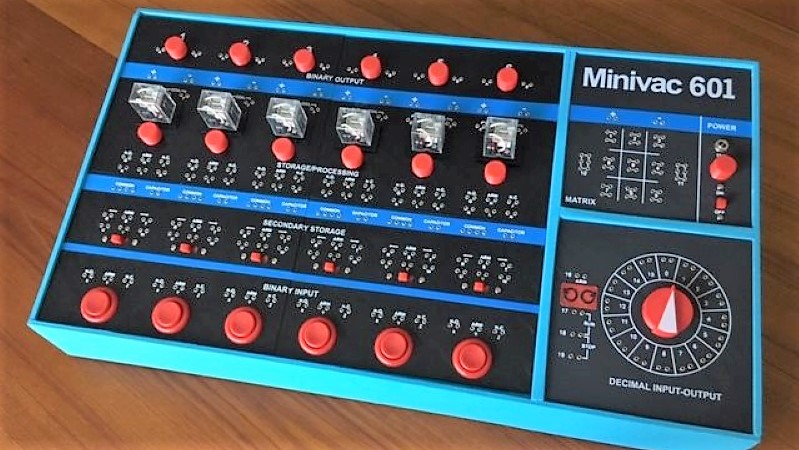OK, here we are at the top of the hour with a lot of new virtual faces. I'm Dan, I'll be your mod today. Let's welcome Mike Gardi to the Hack Chat today, to talk about the wonderful pieces of early computer history he recreates from scratch. Hi Mike!
 Welcome to mike!
Welcome to mike!
 <applause>
<applause>
 For context:
For context:

https://hackaday.com/2019/06/17/a-faithful-replica-of-an-early-computer-trainer/
A Faithful Replica Of An Early Computer Trainer
Turn the clock back six decades or so and imagine you're in the nascent computer business. You know your product has immense value, but only to a limited customer base with the means to afford such devices and the ability to understand them and put them to use.
 Hello Everyone, I'm so glad to be here today. I hope you don't mind but I have a couple of friends here with me today. See above.
Hello Everyone, I'm so glad to be here today. I hope you don't mind but I have a couple of friends here with me today. See above.
 A little bit about me...
A little bit about me...
I'm married with two adult children (that I still think of as kids). Attended the University of Waterloo in the Computer Science program (Class of '82) and have been living in the Waterloo area (about an hour from Toronto) since graduation.
I was in software development my whole career. In the early days I may have done some Cobol, Fortran, and Pascal programming, but mostly I was a C and Java developer (somehow never got involved in C++ work). I retired in April of 2019.
I only started thinking about myself as a "maker" in the past couple of years. I joined the kwartzlab makerspace (https://www.kwartzlab.ca/) last year. I'm having a great time learning new skills and making new friends.
 A caveat...
A caveat...
I'm not a very fast typist. I went to an underfunded Catholic high school, so when my public school buddies were getting a couple of solid years of typing classes I was learning to conjugate verbs in Latin. Sigh. At any rate I have tried to anticipate some of your questions and prepared a few answers.
So don't be fooled if it looks like I'm typing really fast.
 Everyone switch to 110bps stat!
Everyone switch to 110bps stat!
 I took Latin too, it's super useful!
I took Latin too, it's super useful!
 I guess I use typing more often though :-/
I guess I use typing more often though :-/
 hahaha
hahaha
 Don't worry, our server will probably take care of that for us.
Don't worry, our server will probably take care of that for us.
 I am very lucky that I was born at a time where I never had to learn how to properly write. ch@sp3ak 4 the win
I am very lucky that I was born at a time where I never had to learn how to properly write. ch@sp3ak 4 the win
![]() Hi Michael. I have a Minivac 601 but have always been looking for the capacitor add on kit and instruction booklet. Have you encountered this or have any pointers?
Hi Michael. I have a Minivac 601 but have always been looking for the capacitor add on kit and instruction booklet. Have you encountered this or have any pointers?
 I had to learn to type at 3 in order to LOAD games!
I had to learn to type at 3 in order to LOAD games!
 I'm looking at the blog post linked above, but is there a project page to follow progress too?
I'm looking at the blog post linked above, but is there a project page to follow progress too?
 or, I guess it's https://www.instructables.com/id/Minivac-601-Replica-Version-09/
or, I guess it's https://www.instructables.com/id/Minivac-601-Replica-Version-09/
 @carlclaunch51 Sorry I've had no luck tracking down that information.
@carlclaunch51 Sorry I've had no luck tracking down that information.
 I wasn't blogging to Hachaday when I did the Minivac.
I wasn't blogging to Hachaday when I did the Minivac.
![]() @Michael Gardi thats one of the challenges of recreating antique tech - lots of data lots to the mists of sands
@Michael Gardi thats one of the challenges of recreating antique tech - lots of data lots to the mists of sands
![]() I took Latin and typing at the same time in summer school, 5th grade. Let's just say that as much as I understand the value of Latin, typing has been more useful.
I took Latin and typing at the same time in summer school, 5th grade. Let's just say that as much as I understand the value of Latin, typing has been more useful.
 I love this:
I love this:
> the Minivac 601 was ostensibly a toy in the vein of the “100-in-1” electronics kits that would appear later.
That is exactly what I thought of on first glance!
 Mike, what got you started on recreating these artifacts? Did you actually encounter any of these in your early career? Seems like you came online well after these trainers were in their heyday.
Mike, what got you started on recreating these artifacts? Did you actually encounter any of these in your early career? Seems like you came online well after these trainers were in their heyday.
 so the first question that occurred to me is what MCU/processor does it use, and then I realized, I probably don't really even understand how to think about something of this vintage: is it all analog logic?
so the first question that occurred to me is what MCU/processor does it use, and then I realized, I probably don't really even understand how to think about something of this vintage: is it all analog logic?
 Another canned response. Last one I swear...
Another canned response. Last one I swear...
So as to how I started down this rabbit hole...
In 1965 I received a Digi-Comp I as a present. For a 12 year old kid that was already interested in "computers" it was a great gift. I learned about the binary and octal number systems, Boolean algebra, and "programming" (at least how to program a mechanical computer ;-). I'm not saying it was the only reason I ended up in software development, but it was certainly one of them. I had that Digi-Comp I with me through my college years but it was lost in one of my moves after that.
Flash forward to the spring of 2018. I was thinking about buying a 3D printer. I chanced upon a Yahoo group called Friends of DigiComp. There I discovered that Mark Ziemer had modeled a Digi-Comp I and posted the files to Thingiverse. Now I'm not saying that this was the only reason I bought my first 3D printer, but it was one of them.
After I printed a Benchy, a frog, and a whistle, I printed the parts for a Digi-Comp I. I learned how to bend piano wire for the "clock" and "logic" rods and assembled that replica. When It was done and I started playing around with it I could not believe how connected I felt to that 12 year old version of me. I was moved not only the authentic look of Mark's excellent replica, but by the feel and the sounds as I manually "clocked" the device through the counting program I had setup. Wow.
I started looking around for more of the same. I remember being aware of other "computers" back in the 60's primarily Digi-Comp II and GENIAC (thanks to Popular Science), but I never owned one. I was shocked to discover how expensive it would be to buy one of these today in the "vintage" market. So despite my newness to 3D printing and "making" in general (at the time) I decided that these old computer toys deserved to have a new life.
![]() Back when it came out, that was about as close as a young hobbyist could come to an actual computer . The alternatives were Geniac and Digicomp, themselves toy-like but helpful in learning the concepts of logic and computing
Back when it came out, that was about as close as a young hobbyist could come to an actual computer . The alternatives were Geniac and Digicomp, themselves toy-like but helpful in learning the concepts of logic and computing
![]() Ignoring, for a minute, the superset of retrocomputing in general.. where do you place the slider of what qualifies as a retro-computer? with a perfect recreation with period parts on one end and an RTL level emulation in an FPGA at the other?
Ignoring, for a minute, the superset of retrocomputing in general.. where do you place the slider of what qualifies as a retro-computer? with a perfect recreation with period parts on one end and an RTL level emulation in an FPGA at the other?
 @ishotjr - My parents giving me a 100-in-1 kit for Christmas in like 1977 was the turning point for me. Opened up the world to me.
@ishotjr - My parents giving me a 100-in-1 kit for Christmas in like 1977 was the turning point for me. Opened up the world to me.
![]() Once you've manage to build a machine, what do you do about software for it? Is it basically everything from scratch?
Once you've manage to build a machine, what do you do about software for it? Is it basically everything from scratch?
![]() @Michael Gardi if you need detailed pictures of the bottom of the rotary indicator of the Minivac I would be happy to take them
@Michael Gardi if you need detailed pictures of the bottom of the rotary indicator of the Minivac I would be happy to take them
 @Dan Maloney haha I love it, I had one too!!
@Dan Maloney haha I love it, I had one too!!
 @AlanH I actually consider the reproductions I have done to be "vintage" computers. The retro computer club at my makespace is all post microprocessor Apple//, Commodor 64, etc.
@AlanH I actually consider the reproductions I have done to be "vintage" computers. The retro computer club at my makespace is all post microprocessor Apple//, Commodor 64, etc.
![]() The hackchat topic of a 'retrocomputer' wasn't very interesting to me due to the tightly focused scope. I'm building 68K and 8088 FPGA accelerator replacements, an upgraded Amiga A2K motherboard, many different ISA cards, and other retro-computing projects.. but none seem to be on-topic for this hackchat
The hackchat topic of a 'retrocomputer' wasn't very interesting to me due to the tightly focused scope. I'm building 68K and 8088 FPGA accelerator replacements, an upgraded Amiga A2K motherboard, many different ISA cards, and other retro-computing projects.. but none seem to be on-topic for this hackchat
 @carlclaunch51 I have also done Digi-Comp II and GENIAC reproductions ;-)
@carlclaunch51 I have also done Digi-Comp II and GENIAC reproductions ;-)
 @AlanH sounds delightful - do you have links to these projects?
@AlanH sounds delightful - do you have links to these projects?
 The original Paperclip Computer was what got me interested in building discrete logic.
The original Paperclip Computer was what got me interested in building discrete logic.
![]() Putting a vintage CPU, some SRAM, and an I/O controller down on a PCB and interacting with your self-coded boot loader and ROM monitor doesn't seem all that interesting to me
Putting a vintage CPU, some SRAM, and an I/O controller down on a PCB and interacting with your self-coded boot loader and ROM monitor doesn't seem all that interesting to me
 Just to be clear, I used "retrocomputer" in the title of this Hack Chat just because it captured the spirit best - not trying to put a line in the sand about what qualifies as legit retrocomputing
Just to be clear, I used "retrocomputer" in the title of this Hack Chat just because it captured the spirit best - not trying to put a line in the sand about what qualifies as legit retrocomputing
 I'm trying to find a link for my computer-learning-gadget that started me down this path - a bank of 10 multipole, two-throw switches which were connected via a breadboard like front and connected to 10 lamps (not LEDs, but incadescent). Powered by a 4.5V battery.
I'm trying to find a link for my computer-learning-gadget that started me down this path - a bank of 10 multipole, two-throw switches which were connected via a breadboard like front and connected to 10 lamps (not LEDs, but incadescent). Powered by a 4.5V battery.
 @AlanH - I agree. I like the discrete logic recreations, like the Gigatron
@AlanH - I agree. I like the discrete logic recreations, like the Gigatron
![]() @ishotjr most of them are not public yet.. using this years break from vintage computing festivals to drive them all to completion. Will make the rounds at E, W, SE, MW, and Belin next year to show them off
@ishotjr most of them are not public yet.. using this years break from vintage computing festivals to drive them all to completion. Will make the rounds at E, W, SE, MW, and Belin next year to show them off
 @Trenton Henry Software? Sorry these machines were "programmed" with patch panels, switches, and other mechanical means.
@Trenton Henry Software? Sorry these machines were "programmed" with patch panels, switches, and other mechanical means.
![]() @Michael Gardi Even a straight-8 PDP had a bootloader that once toggled in, would load a HLOS from paper-tape
@Michael Gardi Even a straight-8 PDP had a bootloader that once toggled in, would load a HLOS from paper-tape
 The vintage reproductions that I do pre-date bootloaders by a couple of decades.
The vintage reproductions that I do pre-date bootloaders by a couple of decades.
![]() I suppose the way you write code for retro computers matters a lot too. You could sit down with matrix paper, write the instructions down row-by-row, toggle them in and flip 'run'. Or you could use a modern computer to emulate, test, debug code then dump it over a prolog 810 to a 1701a and put it in a socket and flip 'run'.. vastly different
I suppose the way you write code for retro computers matters a lot too. You could sit down with matrix paper, write the instructions down row-by-row, toggle them in and flip 'run'. Or you could use a modern computer to emulate, test, debug code then dump it over a prolog 810 to a 1701a and put it in a socket and flip 'run'.. vastly different
 Again for context...
Again for context...
![]() not sure how you can predate a PDP-8 by 'a couple decades' and still qualify as a computer
not sure how you can predate a PDP-8 by 'a couple decades' and still qualify as a computer
![]() came out in 1965... are you working on pre-ww2 computers?
came out in 1965... are you working on pre-ww2 computers?

 @AlanH as I said, I used the term "retrocomputer" as shorthand for artifacts from the early days of computing that Mike recreates.
@AlanH as I said, I used the term "retrocomputer" as shorthand for artifacts from the early days of computing that Mike recreates.
![]() i just clicked on his io page.. impressive.
i just clicked on his io page.. impressive.
![]() Front panel is beautiful, how did you create the graphics?
Front panel is beautiful, how did you create the graphics?
![]() i'm not sure that meets the definition of a 'computer' though
i'm not sure that meets the definition of a 'computer' though
 The H-500 above is "programmed" by patch panels creating logic circuits.
The H-500 above is "programmed" by patch panels creating logic circuits.
 Hi
Hi
Anyone has a hardware startup in Silicon Valley? I wanna do some free work to get to know the people around here.
My background is in firmware and product design.
Thank you
 Could we agree on proto-computer.
Could we agree on proto-computer.
 Any idea how many of these things Digital made?
Any idea how many of these things Digital made?
 these types of devices feel to me like modular/Eurorack gear as it relates to modern grooveboxes and software - so hands-on, and so direct, and so ephemeral
these types of devices feel to me like modular/Eurorack gear as it relates to modern grooveboxes and software - so hands-on, and so direct, and so ephemeral
![]() an adder can be created by cascaded combinatorial logic. Is that a computer? It compute the sum of two inputs.. the modern definition of a computer is a generally reprogrammable one with state.. Unless you add some flip flops to create an FSM, the expectations of that word get fuzzy
an adder can be created by cascaded combinatorial logic. Is that a computer? It compute the sum of two inputs.. the modern definition of a computer is a generally reprogrammable one with state.. Unless you add some flip flops to create an FSM, the expectations of that word get fuzzy
 It can be difficult to classify some of these machines with modern terminology, but I think proto-computer probably states it pretty succinctly.
It can be difficult to classify some of these machines with modern terminology, but I think proto-computer probably states it pretty succinctly.
![]() is a calculator considered a computer?
is a calculator considered a computer?
 I love the toggles. My use of home wall switches is a far cry from those.
I love the toggles. My use of home wall switches is a far cry from those.
 yes
yes
![]() even a mechanical one?
even a mechanical one?
![]() This is why people sneer at geeks - do we really care about the definition of a retrocomputer? Heck do we care if it is hyphenated or not? This is very cool work, let's go with that.
This is why people sneer at geeks - do we really care about the definition of a retrocomputer? Heck do we care if it is hyphenated or not? This is very cool work, let's go with that.
 OK, @AlanH , we get the point. Can we just move on to concentrate on the really cool things the host has made and not worry about semantics?
OK, @AlanH , we get the point. Can we just move on to concentrate on the really cool things the host has made and not worry about semantics?
 Anyone working on early 6502 devices like AIM oy KIM?
Anyone working on early 6502 devices like AIM oy KIM?
 I feel as though anything capable of discrete logic is a computer
I feel as though anything capable of discrete logic is a computer
![]() Thank you @Dan Maloney
Thank you @Dan Maloney
 @Harold Miller a friend and I are working on our own 6502-based designs
@Harold Miller a friend and I are working on our own 6502-based designs
![]() i thought this was a hack chat...
i thought this was a hack chat...
 In the past five years, I've run into a real live ladder logic system (in active daily use) in my professional life. It's a computer, Jim, but not as we know it. (But people with ties still expect me to hack on it if I want to keep getting paid.)
In the past five years, I've run into a real live ladder logic system (in active daily use) in my professional life. It's a computer, Jim, but not as we know it. (But people with ties still expect me to hack on it if I want to keep getting paid.)
 @Ken Bennett Here is process that I followed for the front panel:
@Ken Bennett Here is process that I followed for the front panel:
I start by trying to find as many pictures of the artifact as possible. Sometimes EBay sellers have the best pictures. In particular I'm on the lookout for a straight on shot of the front of the device without too much perspective distortion to use as my model.
Next I determine the dimensions of the object. I bring the image into Fusion 360 as a canvas and use the dimensions to "calibrate" the image to the model. In some cases this means having to stretch the photo in one dimension to get the aspect ration correct.
Then it's just a matter of "tracing" the project parts with Fusion. I've gotten pretty good at using fit point splines for this.
Fortunately there are many repetitions of the logic elements in the H-500 so not as much work as you might think.
Then I extruded the background in white and the letters and symbols on top of that in black.
![]() Thank you Michael. Great work!
Thank you Michael. Great work!
 Are your switches 3D prints, salvage or "new old stock" ?
Are your switches 3D prints, salvage or "new old stock" ?
 that's astonishing, and inspiring @Michael Gardi !
that's astonishing, and inspiring @Michael Gardi !
 Nice work @Michael Gardi
Nice work @Michael Gardi
![]() this was titled as a retrocomputer hack chat.. i mentioned bootloaders, got shut down... wanted to discuss 'what qualifies as a computer', got shut down... fine.. if you don't want me here, I'll leave
this was titled as a retrocomputer hack chat.. i mentioned bootloaders, got shut down... wanted to discuss 'what qualifies as a computer', got shut down... fine.. if you don't want me here, I'll leave
 I understand that the cost of a vintage unit is prohibitive, but are you able to access any resources like the CHM where you might at least get close to one ?
I understand that the cost of a vintage unit is prohibitive, but are you able to access any resources like the CHM where you might at least get close to one ?
 It's great that you found such a perfect match for the butterscotch color. Was it hard to source filament that matched?
It's great that you found such a perfect match for the butterscotch color. Was it hard to source filament that matched?
 @Dan Maloney The largest serial I've seem was in the 3000's I think. So far as I know they were all made in Canada ;-)
@Dan Maloney The largest serial I've seem was in the 3000's I think. So far as I know they were all made in Canada ;-)
 @AlanH I'm interested in some of the things you've brought up; I think what people are saying is that semantics isn't particularly interesting or productive for this chat
@AlanH I'm interested in some of the things you've brought up; I think what people are saying is that semantics isn't particularly interesting or productive for this chat
![]() @ishotjr correct.
@ishotjr correct.
![]() Are you ever able to locate original dimensional drawings, schematics, BOMs to work from?
Are you ever able to locate original dimensional drawings, schematics, BOMs to work from?
 Cool, I can imagine great squads of sales engineers spreading out across the country with these things in the trunks of their cars
Cool, I can imagine great squads of sales engineers spreading out across the country with these things in the trunks of their cars
 @Dan Maloney Got lucky with the color. It's just AMZ3D light brown.
@Dan Maloney Got lucky with the color. It's just AMZ3D light brown.
 Only somewhat related, but this chat sent me over to read about the SAGE computer network made by IBM in 1957 for radar/missile defense. Total cost 3 times more than the manhattan project, and it was never used to detect a single missile! Ridiculous vacuum tube and suchity such mega project for anyone interested.
Only somewhat related, but this chat sent me over to read about the SAGE computer network made by IBM in 1957 for radar/missile defense. Total cost 3 times more than the manhattan project, and it was never used to detect a single missile! Ridiculous vacuum tube and suchity such mega project for anyone interested.
 @Trenton Henry Not usually lucky with schematics and such. In all cases I have been able to track down the actual manuals that shipped with the original products which were very helpful.
@Trenton Henry Not usually lucky with schematics and such. In all cases I have been able to track down the actual manuals that shipped with the original products which were very helpful.
![]() Manuals sound good. What sorts of things have you programmed them to do (sorry, I have not visited your site yet)
Manuals sound good. What sorts of things have you programmed them to do (sorry, I have not visited your site yet)
 @Michael Gardi forgot to @ you but curious if you have access to the Computer History Museum or similar where reference examples might be found ?
@Michael Gardi forgot to @ you but curious if you have access to the Computer History Museum or similar where reference examples might be found ?
 @Trenton Henry In a could of cases I have connected with owners of the original machines that have been very generous with their time. Most of my reproductions were done with no physical access to originals.
@Trenton Henry In a could of cases I have connected with owners of the original machines that have been very generous with their time. Most of my reproductions were done with no physical access to originals.
 Protip, Mike - the people at the Computer History Museum in SF are super helpful with tracking down old artifacts. If you ever need help getting some info, give them a call.
Protip, Mike - the people at the Computer History Museum in SF are super helpful with tracking down old artifacts. If you ever need help getting some info, give them a call.
@ishotjr - you're reaing my mind...
 :D
:D
 @Dag Spicer was here last week - he's the curator of CHM and they've been super helpful to me in researching articles.
@Dag Spicer was here last week - he's the curator of CHM and they've been super helpful to me in researching articles.
 I've really been fascinated by the blending of this early computing systems and modern construction techniques. The 3D printed replica reed/magnet switches are brilliant, and I'd love to see them used even in contemporary projects.
I've really been fascinated by the blending of this early computing systems and modern construction techniques. The 3D printed replica reed/magnet switches are brilliant, and I'd love to see them used even in contemporary projects.

 oh wow @Dan Maloney ! CHM is heaven, I was lucky enough to visit last December
oh wow @Dan Maloney ! CHM is heaven, I was lucky enough to visit last December
 @ishotjr I have actually make a connection with the curator of the System Source Computer Museum. Bob Roswell has been a great resource.
@ishotjr I have actually make a connection with the curator of the System Source Computer Museum. Bob Roswell has been a great resource.
 @Michael Gardi oh, awesome!!
@Michael Gardi oh, awesome!!
 Ditto that. And that motorized rotary switch from the Minivac-601 was a work of art
Ditto that. And that motorized rotary switch from the Minivac-601 was a work of art

https://hackaday.com/2019/07/13/minivac-601-replica-gets-a-custom-motorized-rotary-switch/
Minivac 601 Replica Gets A Custom Motorized Rotary Switch
One of the joys of electronics as a hobby is how easy it is to get parts. Literally millions of parts are available from thousands of suppliers and hundreds of distributors, and everyone competes with each other to make it as easy as possible to put together an order from a BoM.
 BTW, the Minivac was designed by none other than Claude Shannon, which just blows my mind
BTW, the Minivac was designed by none other than Claude Shannon, which just blows my mind
 It reminds me a bit of people who try to recreate bridge modules from Star Trek. Those 60's rocker switches are bordering on unobtainable, but methods like these could be used to make (visual, anyway) drop-in replacements
It reminds me a bit of people who try to recreate bridge modules from Star Trek. Those 60's rocker switches are bordering on unobtainable, but methods like these could be used to make (visual, anyway) drop-in replacements
![]() He could juggle three of them while riding a unicycle :-)
He could juggle three of them while riding a unicycle :-)
 Brings up a point that I consider my works to be reproductions not replicas. I'm not afraid to give them some new guts and use modern fabrication to get me there. Certainly being able to design some of the unobtainable components (like the rocker switches is a big plus).
Brings up a point that I consider my works to be reproductions not replicas. I'm not afraid to give them some new guts and use modern fabrication to get me there. Certainly being able to design some of the unobtainable components (like the rocker switches is a big plus).
 Just watched a fascinating documentary on Shannon, think it was on Amazon Prime. Dramatized interviews were a bit weird, but it was pretty good nonetheless
Just watched a fascinating documentary on Shannon, think it was on Amazon Prime. Dramatized interviews were a bit weird, but it was pretty good nonetheless
 I think that's a very reasonable trade-off. Using modern parts and fabrication allows a whole new generation to experience these machines.
I think that's a very reasonable trade-off. Using modern parts and fabrication allows a whole new generation to experience these machines.
 @Michael Gardi Have you speculated on making a "limited run" of replicas for people who really want one (=$$$) but unable to build one self
@Michael Gardi Have you speculated on making a "limited run" of replicas for people who really want one (=$$$) but unable to build one self
 Speaking of the rocker switches, kudos on those, are they based on the original design or are they something you worked out.
Speaking of the rocker switches, kudos on those, are they based on the original design or are they something you worked out.
 I wouldn't doubt that you could turn building replica switches into a decent business.
I wouldn't doubt that you could turn building replica switches into a decent business.
 I would order some for sure.
I would order some for sure.
 No I was mor thinking of the whole machine
No I was mor thinking of the whole machine
 I want my projects to be easily recognizable as the originals, and work like the originals. How I get there is wide open and allows me to get creative.
I want my projects to be easily recognizable as the originals, and work like the originals. How I get there is wide open and allows me to get creative.
 @Michael Möller I have made an instance of my WDC-1 for the System Source Computer Museum, but that's not what I want to be doing with my time. I always post an Instructable so that people can make their own if they want.
@Michael Möller I have made an instance of my WDC-1 for the System Source Computer Museum, but that's not what I want to be doing with my time. I always post an Instructable so that people can make their own if they want.
 Neat. Wish a lot of things could be brought back to life to play with, eg the AN/FSQ7 or the whirlwind to get some idea of what it was like to play with any of those.
Neat. Wish a lot of things could be brought back to life to play with, eg the AN/FSQ7 or the whirlwind to get some idea of what it was like to play with any of those.

 That's the paperclip computer, right? Sans paperclips, of course
That's the paperclip computer, right? Sans paperclips, of course
 That is cool.
That is cool.
 More like what I am into.
More like what I am into.
 Right. A Working Digital Computer. From the book by Edward Alcosser, James P. Phillips, and Allen M. Wolk.
Right. A Working Digital Computer. From the book by Edward Alcosser, James P. Phillips, and Allen M. Wolk.
 I had the book back in the 80's and then lost it when it was loaned out.
I had the book back in the 80's and then lost it when it was loaned out.
![]() Thank you for sharing, your work is impressive and inspiring. And thanks to Hackaday for hosting the chat. It would be really cool to do some sort of audio/video chat where we can more easily get the story on the process of creating these machines, and perhaps see them in action. That would be super. This format is fun. but the bandwidth is limited.
Thank you for sharing, your work is impressive and inspiring. And thanks to Hackaday for hosting the chat. It would be really cool to do some sort of audio/video chat where we can more easily get the story on the process of creating these machines, and perhaps see them in action. That would be super. This format is fun. but the bandwidth is limited.
 I vividly remember reading that book on the bus to high school. Mostly I remember the merciless teasing it earned me.
I vividly remember reading that book on the bus to high school. Mostly I remember the merciless teasing it earned me.
 yeah, I like the format, though it's a little tricky w/out moderation/priority given to speaker/etc.
yeah, I like the format, though it's a little tricky w/out moderation/priority given to speaker/etc.
 @Dan Maloney but who got the last laugh? I'm sure those kids retrocomputers are trash!
@Dan Maloney but who got the last laugh? I'm sure those kids retrocomputers are trash!
 @Dan Maloney The teasing is the "Rite of Passaage" we all have to endure to become proper Nerds :-)
@Dan Maloney The teasing is the "Rite of Passaage" we all have to endure to become proper Nerds :-)
 I got plenty of that in the 70's.
I got plenty of that in the 70's.
![]() Thank you for the chat and great work!
Thank you for the chat and great work!
 Oh, I just take a look at my life every day and I know that I won. Don't know how they all did, hope they did well. I know that later, as a volunteer EMT, I peeled a fair number of them off dashboards after they wrecked their cars. So there's that
Oh, I just take a look at my life every day and I know that I won. Don't know how they all did, hope they did well. I know that later, as a volunteer EMT, I peeled a fair number of them off dashboards after they wrecked their cars. So there's that
 :D
:D
 Thank you to @Michael Gardi - why dont you throw up the other canned responses you had ready, then we can think of questions to match?
Thank you to @Michael Gardi - why dont you throw up the other canned responses you had ready, then we can think of questions to match?
 ooo good call!
ooo good call!
 Sure I'll give you a sneak peek at my latest project:
Sure I'll give you a sneak peek at my latest project:
 That sure sounds like a hacker way of doing things!
That sure sounds like a hacker way of doing things!
 and yes, thank you @Michael Gardi !!
and yes, thank you @Michael Gardi !!

 But we digress. We're just about at the top of the hour, and I want to thank Mike for his kind indulgence with our questions and curiosity. I really enjoyed this chat, and I suspect I'm not the only one looking forward to what comes from Mike's shop next. Everyone should feel free to stay on and continue the chat, but we'll say an official thanks to Mike and all for another great chat!
But we digress. We're just about at the top of the hour, and I want to thank Mike for his kind indulgence with our questions and curiosity. I really enjoyed this chat, and I suspect I'm not the only one looking forward to what comes from Mike's shop next. Everyone should feel free to stay on and continue the chat, but we'll say an official thanks to Mike and all for another great chat!
 Oops - called it too early. That's a fascinating little doodad...
Oops - called it too early. That's a fascinating little doodad...
 Good to know that people are there trying to keep this stuff alive though. I do my part, but it's mostly microcomputers and just been going into minicomputer territory
Good to know that people are there trying to keep this stuff alive though. I do my part, but it's mostly microcomputers and just been going into minicomputer territory
 Nice concept :-)
Nice concept :-)
 Very glad that @Michael Gardi could join us for the chat. His projects have been very inspiring, and I'm always excited to see what he's been working on
Very glad that @Michael Gardi could join us for the chat. His projects have been very inspiring, and I'm always excited to see what he's been working on
 Thanks for all the great questions. I had a lot of fun. I'll stick around for a bit.
Thanks for all the great questions. I had a lot of fun. I'll stick around for a bit.
 Was that another trainer?
Was that another trainer?
 I think the best thing is dragging old kit around, and similar experiences to give anyone who will try for a moment. Sometimes they walk away with a new way of doing something that works with today's hardware and software, sometimes it gets a kid interested in coding in assembly.
I think the best thing is dragging old kit around, and similar experiences to give anyone who will try for a moment. Sometimes they walk away with a new way of doing something that works with today's hardware and software, sometimes it gets a kid interested in coding in assembly.
 A lot of the old stuff is totally out of reach for most now, but recreations are not.
A lot of the old stuff is totally out of reach for most now, but recreations are not.
 Wish I could make my projects a small fraction as good looking.
Wish I could make my projects a small fraction as good looking.
 I mean how else are we going to teach the current generation to count in octal and in hex ;D
I mean how else are we going to teach the current generation to count in octal and in hex ;D
 My Turing Machine Demonstrator is (will be) a working Turing machine. I'm just at the point of wiring everything together. The idea is that you program the machine by "filling in" the state transition table with the tiles in the rack to the right in the picture.
My Turing Machine Demonstrator is (will be) a working Turing machine. I'm just at the point of wiring everything together. The idea is that you program the machine by "filling in" the state transition table with the tiles in the rack to the right in the picture.
 Another guy who absolutely nails 3D-printing is @Greg Zumwalt. Mike, you should swap notes with him - I think you'd both up each others' game
Another guy who absolutely nails 3D-printing is @Greg Zumwalt. Mike, you should swap notes with him - I think you'd both up each others' game
 Dan Maloney
Dan Maloney
Discussions
Become a Hackaday.io Member
Create an account to leave a comment. Already have an account? Log In.